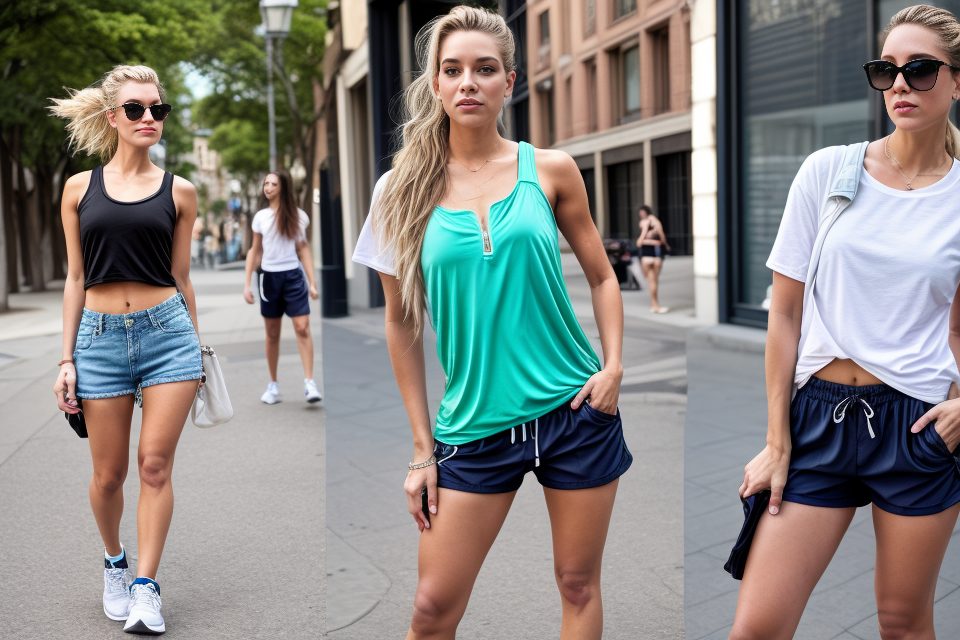When it comes to clothing, it’s easy to get caught up in the details. But what happens when those details become a matter of debate? Take the humble short, for example. Is it just a shorter version of pants, or is there more to the story? In this article, we’ll explore the differences between shorts and pants, and why the distinction matters. So put on your thinking cap, and let’s dive in!
What Exactly Are Shorts?
Types of Shorts
When it comes to shorts, there are various types available in the market. Each type of shorts is designed for a specific purpose and offers a unique set of features. Here are some of the most common types of shorts:
Athletic Shorts
Athletic shorts are designed for active wear and are usually made of moisture-wicking material. They are often used for exercises such as running, cycling, or playing sports. These shorts are usually tight-fitting and provide good mobility, allowing for easy movement during physical activity. They may also have additional features such as pockets for storing small items or compression technology to support muscles.
Casual Shorts
Casual shorts are a popular choice for everyday wear. They are usually made of lightweight fabric such as cotton or linen and are designed to be comfortable and easy to move in. They are often worn with a t-shirt or a casual shirt and can be dressed up or down depending on the occasion. Casual shorts come in a variety of styles, including denim shorts, cargo shorts, and chino shorts.
Swim Shorts
Swim shorts are designed specifically for swimming and are made of quick-drying material. They are often made of a nylon and spandex blend, which provides both flexibility and durability. Swim shorts usually have a tight fit and may have additional features such as a drawstring waistband or a pocket for swimwear. They are also designed to be comfortable in the water and may have features such as a mesh lining or a water-repellent finish.
Dress Shorts
Dress shorts are typically made of a heavier fabric than other types of shorts and are designed to be worn with a dress shirt and dress shoes. They are often made of wool or polyester and are designed to be both comfortable and professional. Dress shorts are often worn to business meetings or formal events and are considered a more formal option than casual shorts.
Materials Used in Shorts
When it comes to the materials used in shorts, there are several options available to suit different preferences and purposes. Here are some of the most common materials used in making shorts:
- Cotton: Cotton is a popular choice for shorts due to its natural comfort and breathability. It is a durable fabric that is easy to care for and can be machine washed without fear of damage.
- Polyester: Polyester is a synthetic material that is known for its strength and resistance to wrinkles. It is often used in activewear as it wicks moisture away from the body, keeping the wearer cool and dry during exercise.
- Nylon: Nylon is another synthetic material that is strong and lightweight. It is often used in outdoor clothing, such as hiking and camping shorts, as it is resistant to abrasion and has a fast drying time.
- Linen: Linen is a natural fabric that is known for its cooling properties. It is a popular choice for summer shorts as it is lightweight and breathable, helping to keep the wearer cool in hot weather.
Overall, the choice of material for shorts will depend on the intended use and personal preferences. Whether it’s cotton, polyester, nylon, or linen, there is a material available to suit everyone’s needs.
What Are Pants?
Types of Pants
Pants, also known as trousers, are a type of garment that covers the lower half of the body, typically worn by individuals of all genders. Pants are often made from a variety of materials, including denim, cotton, wool, and synthetic fabrics.
There are several different types of pants, each with its own unique characteristics and design features. Some of the most common types of pants include:
- Jeans: A type of pants made from denim or a similar fabric, typically worn as a casual, everyday garment. Jeans are often designed with a button-fly, belt loops, and multiple pockets.
- Slacks: A type of pants that are typically made from wool, cotton, or other lightweight fabrics. Slacks are often designed with a straight-leg or slightly tapered leg, and may feature a pleated or flat front.
- Dress pants: A type of pants that are typically worn for formal or business casual occasions. Dress pants are often made from wool, silk, or other luxurious fabrics, and may feature a pleated or flat front, along with a variety of pockets and a belt loop.
- Athletic pants: A type of pants designed for athletic activities, such as running, working out, or playing sports. Athletic pants are often made from moisture-wicking materials, and may feature a elastic waistband or drawstring closure.
Each type of pants has its own unique style and function, and can be worn in a variety of different settings and occasions. Understanding the different types of pants can help individuals choose the right garment for the right occasion, and can also help to ensure that they are dressed appropriately for any given situation.
Materials Used in Pants
Pants are a type of garment that cover the lower half of the body, typically reaching from the waist to the ankles. They are often worn as a form of clothing and can be made from a variety of materials.
Some of the most common materials used in the production of pants include:
- Denim: A sturdy cotton twill fabric that is commonly used in the production of jeans and other casual pants.
- Cotton: A soft, breathable fabric that is often used in the production of dress pants and other formal wear.
- Polyester: A synthetic fabric that is known for its durability and resistance to wrinkles. It is often used in the production of athletic pants and other activewear.
- Wool: A natural fabric that is known for its warmth and insulating properties. It is often used in the production of winter pants and other cold-weather clothing.
In addition to these materials, pants can also be made from a variety of other fabrics, including silk, linen, and synthetic blends. The choice of material often depends on the intended use and style of the pants, as well as personal preferences and fashion trends.
Similarities Between Shorts and Pants
Cut and Fit
When comparing shorts and pants, it is evident that they share some similarities in terms of their cut and fit. Both garments have a waistband, which is a band that encircles the waist and provides support and stability to the garment. The waistband also helps in keeping the shorts or pants in place and prevents them from slipping down.
Additionally, both shorts and pants have a crotchless design, which means that they do not have a seam or a lining in the crotch area. This design allows for greater freedom of movement and comfort, especially during activities that require a wide range of motion.
Moreover, both shorts and pants have two legs, which are designed to cover the legs and provide protection and support to the lower body. The legs of shorts and pants may vary in length, style, and material, but they all serve the same basic purpose of covering the legs.
Despite these similarities, there are also some key differences between shorts and pants in terms of their cut and fit. These differences will be explored in more detail in the following sections.
Purpose
- Both shorts and pants serve the purpose of covering the lower body.
- They are both worn for practical and fashionable reasons.
Shorts and pants may appear to be similar in function, but there are key differences that set them apart. One of the most notable similarities between shorts and pants is their purpose. Both serve the function of covering the lower body, which is crucial for modesty and protection. This shared purpose can be attributed to the fact that the lower body is more prone to injury and exposure than other parts of the body. For example, the legs are susceptible to scrapes, cuts, and sunburns, which can be prevented or mitigated by wearing clothing that covers them.
In addition to their practical purpose, shorts and pants are also worn for fashionable reasons. Clothing is often a form of self-expression, and people may choose to wear shorts or pants based on personal style, cultural norms, and seasonal trends. For instance, some people may prefer to wear shorts in the summer months to stay cool and comfortable, while others may opt for pants in the winter to stay warm and protected from the cold. Ultimately, the purpose of wearing shorts or pants is a personal choice that depends on a variety of factors, including comfort, style, and practicality.
Differences Between Shorts and Pants
Length
Shorts and pants differ significantly in terms of length. Shorts are designed to cover only a portion of the leg, typically extending to mid-thigh or just above the knee. On the other hand, pants are designed to cover the entire leg, extending from the waist to the ankle. The length of pants can vary, with some being longer and others being shorter, but they generally provide more coverage than shorts.
The length of shorts and pants is an important consideration for individuals when choosing what to wear. Shorts may be more appropriate for casual settings or for engaging in activities that require mobility, such as sports or outdoor adventures. Pants, on the other hand, may be more appropriate for formal settings or for colder weather. Additionally, the length of the garment can affect how it fits on the body, with longer pants often providing more warmth and coverage.
While shorts and pants differ in length, they can both be worn for a variety of occasions. Shorts may be more appropriate for warmer weather or for engaging in outdoor activities, while pants may be more appropriate for cooler weather or for more formal settings. Ultimately, the choice between shorts and pants will depend on individual preferences, the occasion, and the climate.
Design
When it comes to the design of shorts and pants, there are several key differences that set them apart. Shorts are typically designed to be worn in warm weather or during physical activities, while pants are designed to be worn in various climates and settings.
Shorts
Shorts are generally designed to be worn above the knee, and they often have a elastic waistband or drawstring to ensure a comfortable fit. They may also have pockets for convenience, and some styles may have zippers or other fasteners. Shorts are often made from lightweight fabrics such as cotton or linen, which help to keep the wearer cool in hot weather. They may also have reinforced seams or other features to improve durability.
Pants
Pants, on the other hand, are designed to cover the entire leg and may have a variety of different fits, such as straight, tapered, or flared. They often have a waistband that sits at the natural waistline, and they may have a zipper, button, or other fastener to close them. Pants may also have pockets, including back pockets, cargo pockets, or other specialized pockets for things like phones or keys. They may be made from a variety of fabrics, including denim, cotton, wool, or synthetic materials.
While both shorts and pants may have similar design features such as pockets or fasteners, the overall design of each garment is tailored to its intended use and setting. Shorts are designed to be a lightweight, casual garment for warm weather or physical activity, while pants are designed to be a more substantial, versatile garment that can be worn in a variety of settings and climates.
Functionality
While shorts and pants may seem similar at first glance, there are several key differences in their functionality. One of the most significant differences lies in the amount of protection and coverage they provide for the legs.
Protection and Coverage
Pants are generally considered to be more protective and coverage-providing than shorts. This is because pants cover the entire length of the legs, providing a barrier between the skin and the environment. In contrast, shorts only cover a portion of the legs, leaving them more exposed to the elements.
Shorts may be suitable for casual wear or for engaging in certain activities, such as playing sports or going for a jog. However, they may not be as appropriate for more formal settings or for situations where additional protection is needed.
Additionally, pants often have additional features that contribute to their functionality. For example, some pants may have reinforced stitching or padding in certain areas to provide extra protection against wear and tear. Other pants may have specialized pockets for carrying items such as phones or keys.
Overall, while shorts may be a convenient and comfortable option for certain situations, pants are generally considered to be more functional due to their ability to provide greater protection and coverage for the legs.
Fashion
While shorts and pants may appear similar at first glance, there are distinct differences in their fashion appeal. Shorts are often seen as a more casual garment compared to pants, which are generally considered to be more formal.
One of the primary distinctions between shorts and pants is their length. Shorts are, as the name suggests, shorter in length, and are typically worn above the knee. In contrast, pants are longer and extend down to the ankles or below. The length of the garment can impact its overall style and is often a factor in determining whether it is appropriate for a particular occasion.
Another key difference between shorts and pants is the material from which they are made. Shorts are often made from lightweight, breathable fabrics such as cotton or linen, which are well-suited for warm weather. Pants, on the other hand, can be made from a variety of materials, including denim, wool, and silk, and are often associated with different seasons and occasions.
Additionally, the fit of shorts and pants can vary significantly. Shorts are often designed to be more loose-fitting, while pants are typically tailored to fit more closely to the body. The fit of a garment can impact its overall style and can affect how it is perceived by others.
In terms of fashion trends, shorts and pants can both be stylish, but they are often associated with different styles. Shorts are often associated with a more casual, beachy style, while pants are often associated with a more formal, business-like style. However, this is not always the case, and both shorts and pants can be dressed up or down depending on the occasion and personal preference.
Overall, while shorts and pants may appear similar, there are distinct differences in their fashion appeal. Shorts are often seen as a more casual garment, while pants are generally considered to be more formal. The length, material, fit, and style of the garment can all impact its overall fashion appeal.
FAQs
1. What are shorts?
Shorts are a type of clothing that cover the lower half of the body, typically stopping at or above the knee. They are often worn as a casual, everyday garment and are commonly made of lightweight fabrics such as cotton or denim.
2. What are pants?
Pants are a type of clothing that cover the lower half of the body and typically reach down to the ankles. They are often worn as a more formal or everyday garment and are commonly made of a variety of fabrics, including denim, wool, and cotton.
3. Is there a difference between shorts and pants?
Yes, there is a difference between shorts and pants. Shorts are a specific type of garment that covers the lower half of the body and typically stops at or above the knee, while pants are a more general term that can refer to any type of lower body garment that covers the legs. Additionally, shorts are often worn as a casual, everyday garment, while pants can be worn in a variety of settings, from casual to formal.
4. Can shorts be considered a type of pant?
No, shorts cannot be considered a type of pant. While shorts and pants are both types of lower body garments, they are distinct from one another and are not interchangeable terms. Shorts are typically worn as a casual, everyday garment and are often made of lightweight fabrics, while pants are a more general term that can refer to a variety of lower body garments made from different fabrics and worn in different settings.
5. Are shorts a good choice for formal occasions?
No, shorts are generally not considered a good choice for formal occasions. While shorts may be appropriate for casual or everyday wear, they are often seen as too informal for more formal settings, such as weddings or business meetings. In these situations, it is generally more appropriate to wear pants or other types of formal wear.



